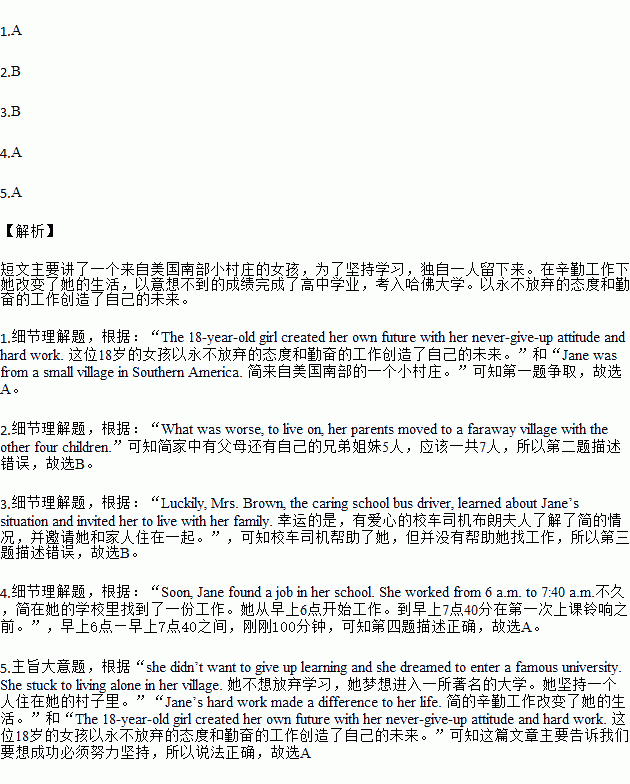题目内容
Jane was from a small village in Southern America. Her family was poor and noodles were often their only food. Her parents couldn’t afford to pay the electricity bill (电费), so she had to study by candle light.
What was worse, to live on, her parents moved to a faraway village with the other four children. As for Jane, she didn’t want to give up learning and she dreamed to enter a famous university. She stuck to living alone in her village.
After Jane’s parents left, she lived a really difficult life. Having no place to live in, the homeless girl had to sleep on the back seat of the school bus. Luckily, Mrs. Brown, the caring school bus driver, learned about Jane’s situation and invited her to live with her family. Soon, Jane found a job in her school. She worked from 6 a.m. to 7:40 a.m. before the first school bell rang. She swept floors and picked up rubbish again in the afternoon. With the money she got from the work, she paid for her education. And she stayed up late in the evenings studying for all kinds of exams day after day.
Jane’s hard work made a difference to her life. She finished high school with unexpected results. She was accepted by Harvard, one of the world’s most famous universities with full scholarship (全额奖学金).
The 18-year-old girl created her own future with her never-give-up attitude and hard work.
根据短文内容判断正、误。
(注意:考生将答题卡相应位置涂黑。正确的涂“A”,错误的涂“B”)
1.The 18-year-old girl who created her own future was from Southern America.
2.There were six people in Jane’s family.
3.The kind school bus driver helped Jane find a job in the school.
4.Jane worked for 100 minutes for the school in a day.
5.The passage tells us that we can get success by working hard and never giving up.
Nathan Sawaya’s childhood was a lot of fun. He drew cartoons, wrote stories, and played with plastic toy bricks (积木). His grandparents bought his first set of toy bricks when he was five years old and he’s been building with toy bricks ever since. He even took his building bricks to college with him instead of books and a computer.
After he left the college, Nathan started as a lawyer first but soon stopped his highly—paid job to become an artist that uses toys in his art. He uses toy bricks to build everything from the Statue of Liberty (自由女神像) to Superman! He has more than 1.5 million colored bricks in his working room in New York which he uses to make pieces of art.
Nathan’s work has appeared in museums around the world. Children love his art because it is made out of the same toys that they play with at home and adults love his work because it is exciting. Since it began in 2007, Nathan’s exhibition “The Art of the Brick" has been very popular with museum visitors everywhere.
“I’m proud that I make my dream come true and what I would like to tell the young is that to do what you love in life is the most important thing.” says Nathan.
根据短文(C)内容完成表格,每空一词
Nathan Sawaya— A Brick 1. | In his childhood | He had fun2. with plastic toy bricks, drawing cartoon and writing. |
After leaving the college | He3.up his highly —paid job as a lawyer to become an artist. | |
After his work appeared in museums around the world | 4.children and adults love his work and his exhibition has been popular with visitors. | |
After making his dream5. true | He told young people that to do what you love in life is the most important thing. |


